Claire Cowie, one of 12 watercolors….
 inspired by Hokusai’s 36 Views of Mount Fuji.
inspired by Hokusai’s 36 Views of Mount Fuji.
 Inka Essenhigh, Blue Wave…
Inka Essenhigh, Blue Wave…
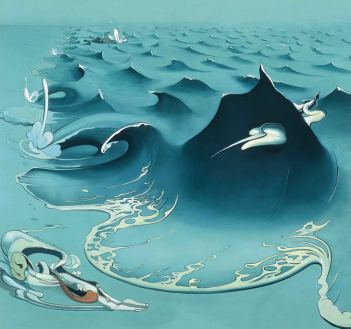 inspired by Hokusai’s The Great Wave.
inspired by Hokusai’s The Great Wave.
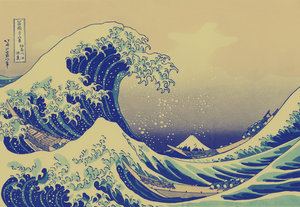
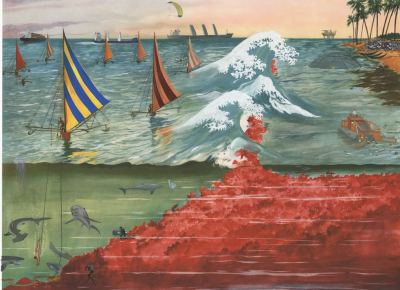
Regina Hackett takes her Art to Go
Claire Cowie, one of 12 watercolors….
 inspired by Hokusai’s 36 Views of Mount Fuji.
inspired by Hokusai’s 36 Views of Mount Fuji.
 Inka Essenhigh, Blue Wave…
Inka Essenhigh, Blue Wave…
 inspired by Hokusai’s The Great Wave.
inspired by Hokusai’s The Great Wave.


(Original post, announcing Betty Bowen Award finalists, here.)
Finalists this year are Jovencio de la Paz and Josh Faught from Oregon; Jenny Heishman, Sean M. Johnson and Matthew Offenbacher from Seattle. The Northwest’s oldest award for visual artists is now $15,000 with two runner-up awards of $2,500. Jen Graves wrote that she thought that Heishman and Offenbacher were the “ones to beat.”
I’m glad I’m not on the jury, because I’d want to give it to all of them. This is the strongest lineup of Bowen finalists in the history of the award. If I had to pick one, it would be Sean M. Johnson, but that’s partly because I know his work best.
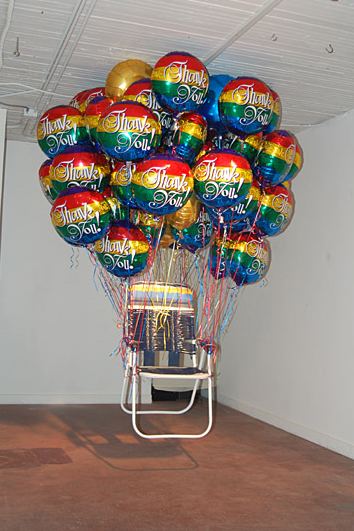
(Photo, Gretchen Bennett)
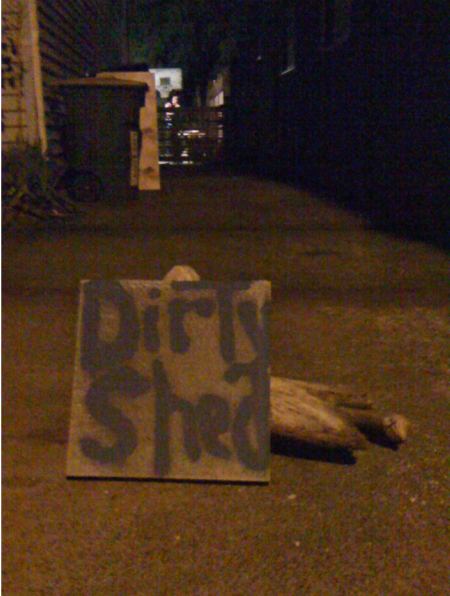 During the day at Seattle’s Dirty Shed, an exhibit conventional in format if not delivery hung on the walls. On
During the day at Seattle’s Dirty Shed, an exhibit conventional in format if not delivery hung on the walls. On
one side were paintings by Jason Hirata. He made them by mixing with
blue pigment the sweat he generated in cleaning out the space.
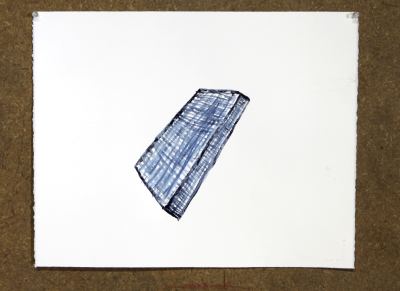 Facing them were the tiny collages of Sol Hasemi. He made them using wood
Facing them were the tiny collages of Sol Hasemi. He made them using wood
samples from a flooring shop with keepsake-tags for scrapbooks ordered
online.
 One, in particular:
One, in particular:
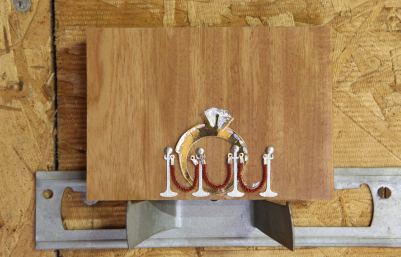 At night, however, Hirata and Hashemi improvised with florescent tubes of light.
At night, however, Hirata and Hashemi improvised with florescent tubes of light.
Photo, Gretchen Bennett. Left to right, Hirata and Hashemi.
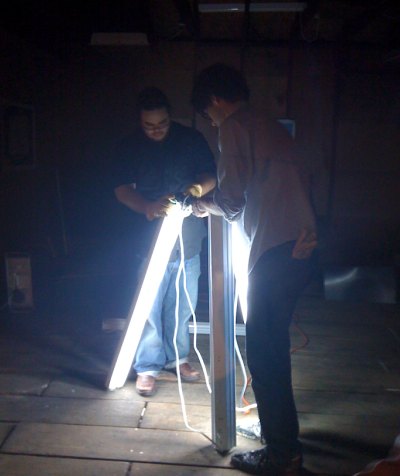
Hoedown from Rodeo from Eleanor Stewart on Vimeo.
Throw Momma From The Train reaches a satisfactory conclusion with the presentation of a pop-up book. In 1987, when the movie came out, such books were slender threads in the world of literature, and their childishness could be assumed as a plot device.
The connective between pop-up and moving image is the flip book. Twenty-two years after momma got the boot, artists have managed to create a form of everything at once: drawings, pop-up books, flip books and videos. William Kentridge comes to mind first of all, but there are many others, including Stewart and, in Seattle, Cat Clifford, her installation below.
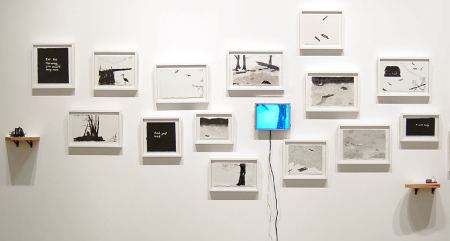
From painter Joanne Mattera, here, including number one, which is, Don’t Jump!
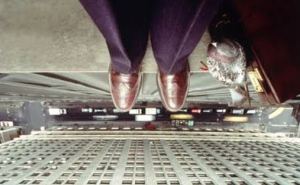
Small world department: Edward Winkleman opened a thread this morning on the subject of dealing with bad reviews.
I’ve written my share, even though if I’ve freely chosen the artist (as opposed to being assigned), I’ve rarely picked someone whose work I find to be without consequence.
A review is an engagement, an examination of the specifics of a response written to evoke response in others. Who wants to dance with the dead? Nothing will come of nothing. As Grace Paley noted, where there is real disagreement, there’s no point arguing.
At worst, a review articulates the limits of a critic’s imagination. (I can’t see you.) A negative may be intended by critics as a prod, but it always serves as their mirror.
Hyman Bloom died Wednesday at age 96. (Holland Cotter’s obit here. Image via Art Critical.)
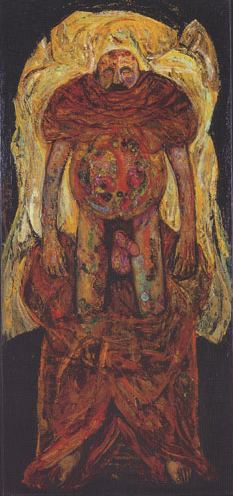 Selma Waldman died last year in Seattle at age 78.(My obit here. Images via Center for Holocaust and Genocide Studies.)
Selma Waldman died last year in Seattle at age 78.(My obit here. Images via Center for Holocaust and Genocide Studies.)
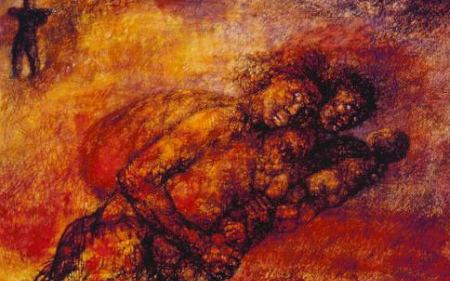
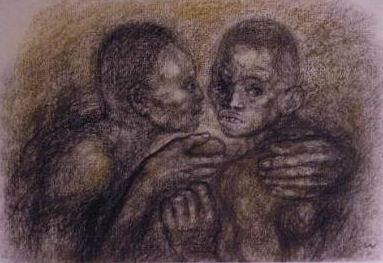 Although he enjoyed wide critical favor in the 1950s, both artists are essentially outsiders. They are center stage in a particular moment only in so far as their work is misunderstood in it. Where they find resonance is with each other.
Although he enjoyed wide critical favor in the 1950s, both artists are essentially outsiders. They are center stage in a particular moment only in so far as their work is misunderstood in it. Where they find resonance is with each other.
Even though he was mystical and she materialist, they are each best understood in the context of their shared Jewish culture, what Bloom called a “weeping from the heart.” A weeping and a joy. Jewish culture was existentialist thousands of years before the French defined the term. Bloom and Waldman confront the horrors of life and pay them back with radiance.
Artists love Project Runway, but PR doesn’t love them back. In the first two episodes, it managed to eliminate the two people whose aesthetic is way off-the-rack.
Dave White on first episode:
Verdict: LiLo took out her frustrations on the girl who looked like Sam Ronson. All the judges did. And I think that cheats us, the viewers. Because how many short-haired, pixie-ish, spaced-out-art-girls-who-could-very-easily-be-lesbians do we ever get on Runway?
PRECIOUS FEW. THAT’S HOW MANY.
This show has homos seeping from its pores. Boring, tacky, annoying ones most of the time. What happened to the days when an allegedly talented lady-person could simply arrive at Parsons — oh, wait, no, now it’s FIDM — and just waltz through this show, creating at least a few sub-Bjork garments out of puffy, metallic, octagonal empanadas that also feature their own water purification systems inside a hood made of charcoal and shards of glass and go, “TA-DAAAH!” before being shown the door? Can’t they, instead, eliminate one of the dullards first? …When Kors called her final product a “disco soccerball,” I thought, “Fuckin’ right it’s a disco soccerball. Not enough of those in the world.” more
Moving on. White knows how.
Meanwhile, my first favorite person of the new season, now that Planet Claire is already out of the picture, is Malvin with the Haysi Fantayzee hair. He says shit like “my design is ineffable” and that “there’s not a vocab for it yet.” He’s so far into the future there’s no known language developed that can adequately communicate his fashion brilliance. Maybe by the end of the season some really chic aliens will land and teach us all how to see and speak of Malvin’s work with the garbled respect it deserves. I want to believe.
As we all know, Malvin’s gone too. All dullards are still standing. White on episode two here.

Therman Statom had the glass-house-as-sculpture field to himself, beginning in the 1970s.
In the 1990s, Louise Bourgeois muscled her way in.
(Cell (Glass spheres and hands), 1990-1993)
 Statom’s houses are a solace and Bourgeois’ suitable for involuntary confinement. Somewhere between these polarities are all later entries into what’s becoming a crowded field.
Statom’s houses are a solace and Bourgeois’ suitable for involuntary confinement. Somewhere between these polarities are all later entries into what’s becoming a crowded field.
Deb Jones – (I’m being followed by a moon shadow.)

Giles Bettison – House as a consumer product. Your life in your purse.
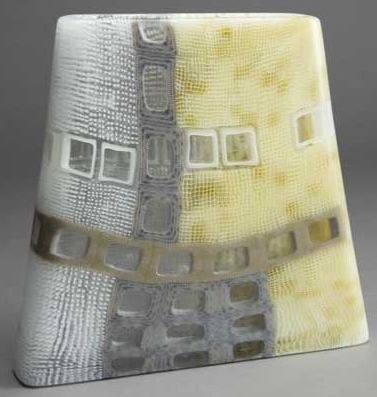
Jane Bruce – Down the hatch.

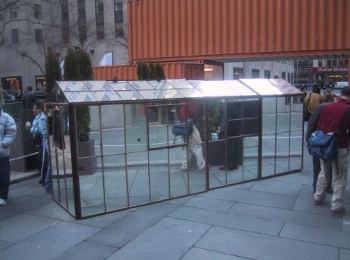 Rik Allen – Your portable escape plan; there’s a hell of a good universe next door.
Rik Allen – Your portable escape plan; there’s a hell of a good universe next door.
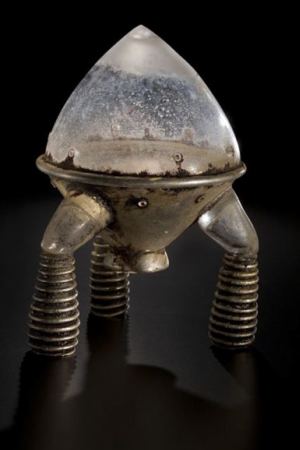
Bad news from Portland, via VSversus:
There is an amazing auction happening right now, to benefit a dear friend of mine. Rachael Jensen, a dazzling member of the band Parenthetical Girls, has suffered a major tragedy.
Four members of her immediate family were involved in a fatal car accident while traveling home from an annual family reunion. Her father and two brothers were rushed to an intensive care facility, and are now in the early stages of their recovery. Tragically, family matron Kris Jensen, 51, passed away at the scene. Kris’ extreme kindness and exuberance touched a tremendous number of people, but it was her particular enthusiasm for music and generosity with musicians that broadened her impact to so many people in our community.
I don’t know how to fix this heartbreak, but I do know that we can raise some money. (more)
Parenthetical Girls will play in Seattle at Bumbershoot, Sept. 6.
an ArtsJournal blog


